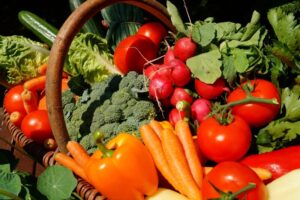Professional Register of
Traditional Chinese Medicine

Fresh and seasonal food
Food therapy is a cornerstone of Traditional Chinese Medicine (TCM), focusing on using food to promote health, prevent illness, and to help to treat disease. Rooted in the belief that Chinese Food Therapy and Chinese Herbal Medicine share the same origins, TCM views dietary habits as a powerful tool to maintain harmony within the body. According to TCM theory, food therapy works by balancing the Yin and Yang within the body and aligning an individual's diet with their unique constitution and health condition.
Now it is Harvest time which is traditionally a time to gather the crops that we have sown and tended to over the past couple of seasons. Nowadays, we have a wide variety of foods available to us, and there are many different diets going in and out of fashion, so it is harder to know which food choices or habits are best suited to us. TCM makes this less complicated with its tried and tested experience in Food Therapy.
Food, in Chinese medical terms, is classified based on its energy, taste, and effect on the body. There are five key flavours—sweet, sour, bitter, salty, and pungent—each associated with a different Zangfu or function within the body. For example, sweet foods - in moderate amounts - are believed to nourish the Pi and Wei, although excess consumption of sweet foods can damage Pi and Wei. Sour flavours, to give another example, are linked to the Gan and Dan. As a general rule it is considered to be a good thing to consume some food from each of the 5 flavour categories each day and not to excessively focus on one particular flavour.
Foods have energetic properties, such as warm, cool, hot, cold, or neutral, which are said to affect the state of the person's Qi. So, someone who is regularly experiencing excessive "Heat" might be advised, as a first step in TCM Food therapy, to reduce their intake of "heating" foods such as ginger, lamb or curries. The first rule of Food therapy is to reduce the foods that are exacerbating the condition. The second phase might be to introduce more foods of a different character and Qi quality.
As a general rule, all client are advised to avoid excess in everything, so in food terms, this means avoiding, or at least limiting, excessively Hot or Cold energy foods.
Tailored to the season and the individual
Environmental factors like climate and season are an important consideration in choosing which foods to eat. According to Chinese Medical Food Therapy we should be eating food that is fresh, recently harvested and grown locally. It should be seasonal and still be full of Qi when we eat it.
Food therapy in TCM is also highly personalised, taking into account an individual's constitution and current health status, so it is difficult for an individual to work out more precisely the best foods for themselves. However, a TCM Practitioner using Acupuncture, or Chinese Herbal Medicine or Medical Qigong, will be able to offer more individualised food therapy advice as part of their treatment plan.
For a list of fully qualified and insured practitioners see our members list and find the contact details of your nearest practitioner.
For questions or comments, you can reach us through our Contact Us page.